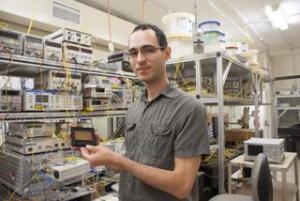Nov 14 2014
An optical oscilloscope with 20 times the resolution of conventional electronics has been developed by the ARC Centre for ultrahigh bandwidth devices for optical systems (CUDOS) at the University of Sydney and the Australian National University.
 This is Dr Simon Lefrancois from the University of Sydney's School of Physics holding a chalcogenide optical chip used in the terabit oscilloscope.
This is Dr Simon Lefrancois from the University of Sydney's School of Physics holding a chalcogenide optical chip used in the terabit oscilloscope.
"This is a major advance in a crucial diagnostic tool for next-generation ultrafast fibre optics communications systems used for broadband internet and cloud computing. It is made possible by our collaboration with Alnair Labs Corporation in Tokyo," said Professor Ben Eggleton, director of CUDOS.
"It opens the way for jump-starting the creation of an Australian optical chip foundry based on the local manufacture of highly specialised glasses used for low power, high speed processing on compact chips. We are well advanced in our talks with Alnair Labs about commercial scale supply of this technology."
The opening next year of the Australian Institute for Nanoscience at the University of Sydney and the Australian National Fabrication Facility node at the Australian National University means Australia is perfectly positioned to produce the world-class technology developed by this research.
CEO of Alnair Labs Dr Sze Set said, "This achievement is exciting proof of how industry and academia can collaborate on a global scale to realise the next generation of photonic technology with the potential for commercialisation."
An article (attached) on the development of the oscilloscope will be presented this Friday, 14 November at a session of the Asia Communications and Photonics Conference in Shanghai, an annual gathering of the leading researchers worldwide in photonics and communications.
Dr Simon Lefrancois, from the University of Sydney's School of Physics, lead author of the article to be presented, said:
"This is the culmination of four years of research and discussion with our industry partners. The ultrahigh resolution we have achieved is made possible by directly analysing the optical data with a laser beam rather than converting it to a slower electric signal. Our specialty glass greatly enhances the sensitivity of this interaction so that it can be done with low powers on a compact optical chip."
CUDOS is providing the chalcogenide glass optical chips using unique nano-fabrication capabilities developed in Australia.
The laser for optical data analysis is based on Alnair Labs' patented carbon nanotube short pulse technology.
The result is an instrument capable of directly resolving the terabit data signals (a thousand billion data pulses per second) being researched for next generation fibre optics super-channels.